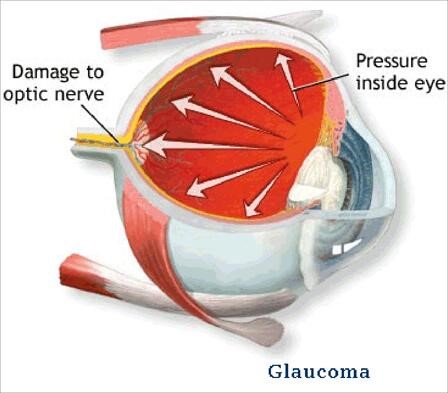Glaucoma
Chengdu Aier East Eye Hospital
Glaucoma is a complicated disease in which damage to the optic nerve leads to progressive, irreversible vision loss. Glaucoma is the second leading cause of blindness.
As its nickname "silent thief of sight” indicates, glaucoma causes the loss of vision gradually over a long period of time, and only presents symptoms when the disease is quite advanced. However, when it’s to the level the symptoms present themselves, the damages glaucoma does to the sight are irreversible because the damages to the optic nerves annot be repaired. So regular eye checkup aiming early detection early treatment is essential in preventing and managing glaucoma.
What causes glaucoma
Glaucoma occurs when the intraocular pressure within the eyeball is too high and damages the optic nerve, which passes visual impulses from the eye to the brain. This pressure build-up occurs because of an imbalance between the production and drainage of fluid within the eyeball.

Other causes
There are various other factors that can lead to glaucoma.
•Age—chronic glaucoma becomes more likely as you get older.
Ethnic origin—people of African, or Afro-Caribbean origin, tend to have a greater chance of developing chronic glaucoma. Also, people of Asian origin are more likely to develop acute glaucoma.
•Short sightedness—people who are short-sighted are more likely to develop to chronic glaucoma.
•Family history— if you have a close relative, such as a parent, brother, or sister who has glaucoma, you may also have a increased chance of developing the condition yourself. You should therefore have regular eye tests in order to monitor the condition of your eyes.
•Medical history—research suggests that people with diabetes are also more likely to develop glaucoma than those without the condition.
Types of Glaucoma
•Primary Open Angle Glaucoma (POAG)—the most common type of glaucoma
It is chronic, progressive and painless. It occurs when the drainage system that controls the flow of fluid inside the eye is defective. With POAG, the IOP inside the eye slowly rises, causing damage to the optic nerve.
This will cause a visual field defect, but often the vision loss is not apparent until it is advanced, as the good eye typically fills in for the damaged one.
•Normal Tension Glaucoma (NTG)
NTG is defined as optic nerve damage occurring in individuals where the eye pressure is within a normal range.
•Ocular Hypertension (OHT)
OHT is where an individual has consistent high pressure with no sign of damage to the optic nerve. From this, we know that high IOP may not always result in glaucoma.
•Acute Angle Closure Glaucoma (AACG)
AACG is a sight threatening emergency which occurs because of an apposition of the natural lens to the back of the iris.
AACG needs immediate treatment, so you should contact an eye professional straight away.
Due to the rapid development of acute glaucoma, the symptoms are often severe. They include:
•Pain in the eye
•Nausea and vomiting
•Sudden onset of visual disturbance
•Halos around lights
•Blurred vision
•Redness of the eye
•Secondary Glaucoma
As secondary glaucoma is caused by other conditions, or eye injuries, it is possible that the symptoms of glaucoma itself may be confused with the original cause. However, the glaucoma may still cause misty vision, and rings, or halos, around light sources. This can be any kind of glaucoma, but its cause is secondary in nature, for example as a result of certain drugs (e.g. steroids), other eye conditions (e.g. diabetes) or trauma to the eye.
•Congenital Glaucoma(developmental glaucoma)
This is a rare condition caused by developmental malformation of the eyeball.
Treatments & Suggestions
Glaucoma cannot be cured, but it can be successfully controlled in most cases. Treatment depends on the type of glaucoma you are diagnosed with. It may be in the form of medication, laser or surgery.
The initial treatment is generally with the use of eye drops that lower the intraocular pressure. Most of the time a drop or combination of drops keeps the IOP within the target range.
For more advanced cases, laser treatments and traditional surgery options are all available.
Aier East is equipped with the latest diagnostic devices for the early detection of glaucoma and we are rich in experience of treating and long-term controlling various types of glaucoma. Aier experts opened a new pathway by designing the aqueous humor drainage device implantation for refractory glaucoma.